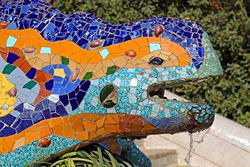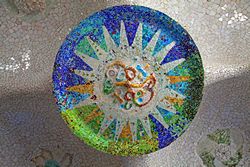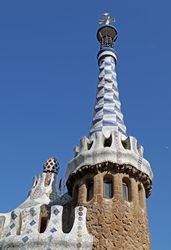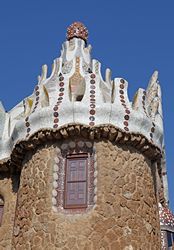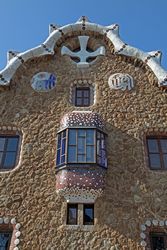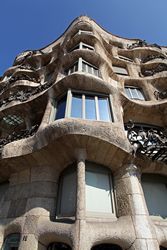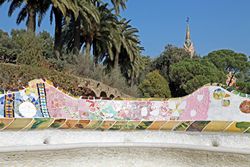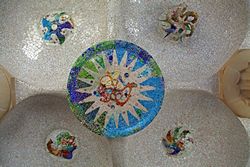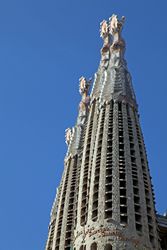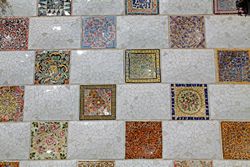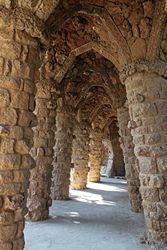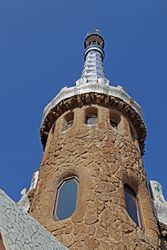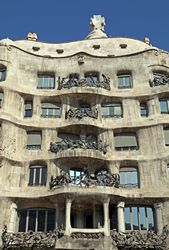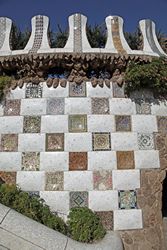BG1 - Dragon Fountain:One of Gaudi's most interesting sculptures is a fountain named "the Dragon", symbol of fire and alchemy. It's located underneath the terrace of Park Güell, and at the top of the major stairs. |
BG2 - Dragon Fountain: The distinctive method he uses, known as ‘trencadís’, can be described as joining together bits of broken tiles, dishes and glass to create astonishing art. |
BG3 - Ceiling in the "Salon of the Hundred Columns": At the top of the main staircase in Park Güell is the Salon of the Hundred Columns, which was supposed to be a market place. In fact there are only 84 columns which are Doric in form. |
BG4 - Park Güell: The entrance gate is flanked by two buildings. The pavilions are integrated into the park wall. The building on the left is in the form of tower topped with a cross with a maximum height of 17 meters.
| BG5 - Park Güell: The building on the right, is more compact and housing like. Its interior is more orderly and symmetrical. The roof is a cone topped with a peak with ornate decoration. |
BG6 - Park Güell: Small windows are located on the front and the interior, all decorated individually.
|
BG8 - Casa Milà: Casa Milà, commonly known as La Pedrera is the largest civil building designed by Antoni Gaudí. The apartment block was constructed between 1906 and 1910. |
BG9 - Casa Milà: the Casa Milà breaks with traditional architecture by using not a single straight line. The building does not use load-bearing walls, but rest on pillars and arches. |
|
BG10 - Serpentine Bench: On top of the salon is a public square with a very large undulating bench in the form of a sea serpent that has backrests adorned with the broken bits of glazed tile. |
BG11 - Ceiling in the "Salon of the Hundred Columns": The ceiling of the Salon has tiled mosaics with designs on the ceiling. |
BG12 - Park Güell: Count Eusebi Güell was a prominent industrialist in Barcelona who was inspired to build a garden city with 60 houses on a hill called Montaña Pelada (Bare Mountain). |
BG13 - Sagrada Família: The Sagrada Família is Antoni Gaudí's unfinished masterpiece. Started in 1882 by the Architect Paula del Villar, Gaudi took over as lead architect a year later and devoted most of his life to the construction of the church. |
BG14 - Park Güell, Tiled Wall: Gaudí also adorned many of his buildings with coloured tiles arranged in mosaic patterns. This added another important dimension to his buildings which is so often overlooked by architects - the use of colour. |
BG15 - Lovers Viaduct: Inspired from the idea of roman viaducts, this one, in Park Güell, is called "Viaducto de los Enamorados" (Lover's Viaduct). |
BG16 - Park Güell: The park was designed by prominent architect, Antoni Gaudi, and built between 1900 and 1914. |
BG17 - Casa Milà: On the exterior, the undulating balconies look like a series of waves. The iron-wrought balconies were designed by Josep Maria Jujol, who improvised on the spot. |
BG18 - Park Güell, Tiled Wall: The combination of original design, interesting shaped stonework, and vibrant colours in Gaudí's work give the viewer a truly breathtaking visual experience. |

